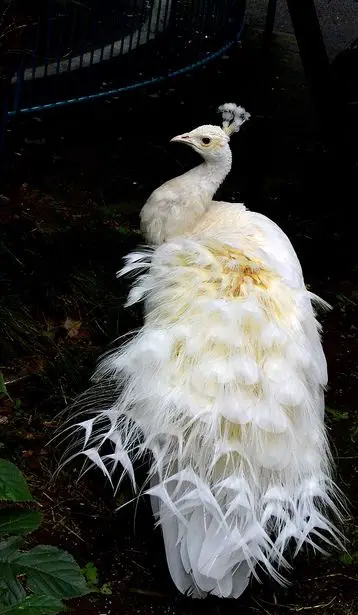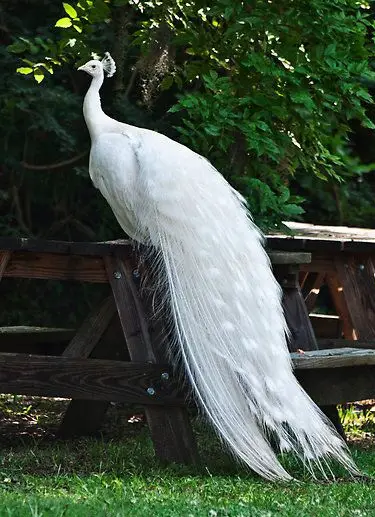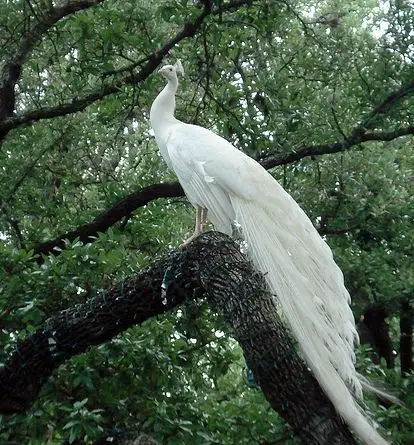The white peacock, also known as the Indian white peafowl, is a rare and beautiful bird that is a genetic mutation of the more common blue peacock. Unlike its blue counterpart, which is known for its vibrant and colorful plumage, the white peacock has pure white feathers with hints of cream and pale blue.
The white peacock is native to the Indian subcontinent, where it has long been revered for its beauty and grace. In Hindu mythology, the peacock is considered a sacred bird and is associated with the god Kartikeya, who is often depicted riding on the back of a peacock.

White Peacock Symbolism
The white peacock is a rare genetic variant of the more common blue peacock. In many cultures, the white peacock is associated with symbolism and meaning that is often different from that of the blue peacock. Here are some of the common symbolic meanings associated with the white peacock:
Purity and innocence:
The white color of the peacock is often associated with purity and innocence. In many cultures, the white peacock is a symbol of divine presence, and is often associated with deities or angels.
Spiritual awakening:
In some spiritual traditions, the white peacock is seen as a symbol of spiritual awakening and enlightenment. It is believed that the peacock’s beautiful feathers represent the opening of the third eye, which is associated with spiritual insight and intuition.
Resurrection and rebirth:
The peacock is known for shedding its feathers and regrowing new ones, which is why it is often associated with resurrection and rebirth. The white peacock, in particular, is seen as a symbol of purity and new beginnings.
Royalty and luxury:
In some cultures, the white peacock is seen as a symbol of royalty and luxury. Its elegant and regal appearance is often associated with wealth, power, and status.
Good luck and prosperity:
In some cultures, the white peacock is seen as a symbol of good luck and prosperity. It is believed that the peacock’s beautiful feathers bring good fortune and success to those who possess them.
Some Facts about White Peacock
- White peacocks are a genetic variant of the more common Indian Blue peacock (Pavo cristatus), which is native to the Indian subcontinent.
- The white color of the peacock’s feathers is not caused by albinism, but rather a genetic mutation called leucism, which prevents the production of pigments in the feathers.
- White peacocks have the same physical features as Indian Blue peacocks, including the long, iridescent tail feathers that are used to attract mates during courtship displays.
- White peacocks are not as common as Indian Blue peacocks, and are often considered more rare and exotic.
- The white peacock is not a separate species of peafowl, but rather a color variation of the Indian Blue peacock.
- White peacocks are highly prized by breeders and collectors for their unique and striking appearance.
- White peacocks are not fully white, but rather have a mix of white and pale blue feathers, with a white body and tail.
- White peacocks are typically larger than Indian Blue peacocks, and may weigh up to 15 pounds.
- White peacocks are generally less aggressive than Indian Blue peacocks, and are known for their gentle nature and calm temperament.
- White peacocks are often used in cultural and religious celebrations in India, and are considered a symbol of purity, peace, and prosperity.
How rare are white peacocks?

White peacocks are considered rare, as they are a genetic mutation of the Indian blue peafowl, which is the most common peacock species.
What does a white peacock symbolize?
White peacocks symbolize purity, spirituality, and new beginnings in many cultures. In some religions, they are also associated with resurrection and immortality.
Where are white peacock found?
White peacocks are found in captivity in various parts of the world, including the United States, Europe, and Asia. They are not commonly found in the wild, as their white feathers make them more visible to predators.

What is a white peacock called?
A white peacock is simply called a white peacock, as it is a variant of the Indian blue peafowl.
Is White Peacock real?
Yes, white peacocks are real and are a genetic mutation of the Indian blue peafowl.Pick some White peacock from us

How many colors of peacock are there?
There is only one species of peafowl, which is the Indian blue peafowl (Pavo cristatus). However, there are several color variants of this species, including white, black-shouldered, and pied.
How expensive is a white peacock?
The cost of a white peacock can vary depending on several factors such as its age, gender, and location. Generally, they are more expensive than their blue counterparts due to their rarity and unique appearance.
How much does a white peacock cost?
The cost of a white peacock can range from a few hundred to several thousand dollars.
Is a white peacock a female?
No, a white peacock is not a female. Both male and female peafowl have a similar appearance, but only the male peafowl (peacock) has the long and colorful feathers.
Which peacock is most beautiful?
Beauty is subjective, and every peacock variant has its unique charm. However, the Indian blue peafowl is the most common and widely recognized peacock species, known for its striking blue and green plumage.
Conclusion
Despite its beauty, the white peacock has faced challenges in the wild due to habitat loss and hunting. Conservation efforts, such as those carried out by organizations like the World Wildlife Fund and local conservation groups, are crucial to ensure the survival of this magnificent bird for future generations to enjoy.